Principles of Torque Production | Electrical Machines - Electrical Engineering (EE) PDF Download
| Table of contents |

|
| Introduction |

|
| From the foregoing, the following may be noted: |

|
| Calculations: |

|
| Maximum Torque Condition for Three-Phase Induction Motor |

|
Introduction
In the earlier section, we saw how a rotating flux is produced. Now let us consider a rotor, which is placed in this field.
- Let the rotor have a coil such that the coil sides are placed diametrically opposite each other. Since the flux generated by the stator rotates flux linked by this rotor coil also changes.
- Since the flux pattern varies sinusoidally in space, the flux linkage varies sinusoidally as the flux waveform rotates. The rate of variation of this flux linkage will then be equal to the speed of rotation of the air gap flux produced. This sinusoidal variation of the flux linkage produces a sinusoidal-induced emf in the rotor coil. If the coil is short-circuited, this induced emf will cause a current flow in the coil as per Lenz’s law.
- Now imagine a second coil on the rotor whose axis is 120º away from the first. The flux linkage in this coil will also vary sinusoidally with respect to time and therefore cause an induced voltage varying sinusoidally with time. However, the flux linkages in these two coils will have a phase difference of 120º (the rotating flux wave will have to travel 120º in order to cause a similar flux linkage variation as in the first coil), and hence the time-varying voltages induced in the coils will also have a 120º phase difference.
- A third coil placed a further 120º away is shown in fig. 3. This will have a time-varying induced emf lagging 240º in time with respect to the first.
- When these three coils are shorted upon themselves, currents flow in them as per Lenz’s law. The mechanism by which torque is produced may now be understood as follows. The diagram in fig. 4 shows a view of the rotor seen from one end. Positive current is said to flow in these coils when current flows out of the page in a, b, c conductors and into a', b', and c' respectively.
A Coil Displaced 120º from the first
 A Coil Displaced 240◦ from the first
A Coil Displaced 240◦ from the first
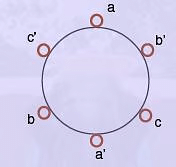 Coils on the Rotor
Coils on the Rotor
- If we look at the voltage induced in these coils as phasors, the diagram looks as shown . The main flux is taken as the reference phasor. Considering that the induced emf is —dψ/dt where ψ is the flux linkage, the diagram is drawn as shown.
- As usual, the horizontal component of these phasors gives the instantaneous values of the induced emf in these coils.
- Let these coils be purely resistive. Then these emf phasors also represent the currents flowing in these coils. If we consider the instant t = 0, it can be seen that
- The field flux is along 0º axis.
- The current in a phase coil is zero.
- The current in b phase coil is
- The current in c phase coil is
- These currents act to produce mmf and flux along the axes of the respective coils. Let us consider the space around b' and c coil sides. The situation is shown in diagram below.
- The resulting flux pattern causes a tendency to move in the anticlockwise direction. This is easy to see through the so called whiplash rule. Alternatively, since the force on a current carrying conductor is
, it can be seen that the torque produced tends to rotate the rotor counter-clockwise. The magnitude of the torque would increase with the current magnitude in the coils. This current is in turn dependent on the magnitude of the main field flux and its speed of rotation. Therefore one may say that motion of the main field tends to drag the rotor along with it.
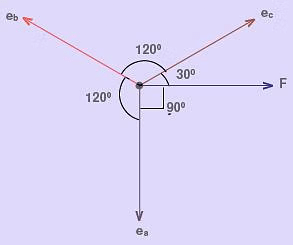 EMF induced in the coils : Resistive rotor
EMF induced in the coils : Resistive rotor
 Flux around conductors : Resistive rotor
Flux around conductors : Resistive rotor
- When the rotor is free to move and begins moving, the motion reduces the relative speed between the main field and the rotor coils. Less emf would therefore be induced and the torque would come down. Depending on the torque requirement for the load, the difference in speed between the rotor and the main field settles down at some particular value.
From the foregoing, the following may be noted:
1. The torque produced depends on a non-zero relative speed between the field and the rotor.
2. It is therefore not possible for the rotor to run continuously at the same speed of the field. This is so because in such a condition, no emf would be induced in the rotor and hence no rotor current, no torque.
3. The frequency of currents induced in the rotor coils and their magnitude depends on this difference in speed.
These are important conclusions. The speed of the main field is known as the synchronous speed, ns. If the actual speed of the rotor is nr then the ratio
(5)
is known as slip and is frequently expressed as a percentage.
- Typically induction machines are designed to operate at about less than 4 percent slip at full load.
- It is instructive to see the situation if the rotor resistance is neglected and is considered to be purely inductive. The phasor diagram of voltages and the currents would then look as shown in figure below.
EMF induced in coils : Inductive rotor
- At t = 0, one can see that current in a phase coil is at negative maximum, while b and c phases have positive current of 0.5 units. Now if we consider the current flux profiles at coil sides a, b' , c, the picture that emerges is shown in figure below.
- Since main flux at the a coil side is close to zero, there is very little torque produced from there. There is a tendency to move due to the b and c coil sides, but they are in opposite directions however. Hence there is no net torque on the rotor. This brings up another important conclusion — the resistance of the rotor is an important part of torque production in the induction machine. While a high resistance rotor is better suited for torque production, it would also be lossy.
Flux around conductors : Inductive rotor
Calculations:
The flux φ produced by the stator is proportional to stator emf E1. i.e φ ∝ E1
We know that transformation ratio K is defined as the ratio of secondary voltage (rotor voltage) to that of primary voltage (stator voltage). Rotor current I2 is defined as the ratio of rotor induced emf under running condition , sE2 to total impedance, Z2 of rotor side,
Rotor current I2 is defined as the ratio of rotor induced emf under running condition , sE2 to total impedance, Z2 of rotor side,
and total impedance Z2 on rotor side is given by , Putting this value in above equation we get,
Putting this value in above equation we get, s = slip of induction motor
s = slip of induction motor
We know that power factor is defined as ratio of resistance to that of impedance. The power factor of the rotor circuit is Putting the value of flux φ, rotor current I2, power factor cosθ2 in the equation of torque we get,
Putting the value of flux φ, rotor current I2, power factor cosθ2 in the equation of torque we get,
Combining similar term we get, Removing proportionality constant we get,
Removing proportionality constant we get, Where, ns is synchronous speed in r. p. s, ns = Ns / 60. So, finally the equation of torque becomes,
Where, ns is synchronous speed in r. p. s, ns = Ns / 60. So, finally the equation of torque becomes, How the constant K is derived in the torque equation.In a three phase induction motor, copper losses typically occur in the rotor. These rotor copper losses are expressed as
How the constant K is derived in the torque equation.In a three phase induction motor, copper losses typically occur in the rotor. These rotor copper losses are expressed as
Pc = 3I22R2
We know that rotor current, Substitute this value of I2 in the equation of rotor copper losses, Pc. So, we get
Substitute this value of I2 in the equation of rotor copper losses, Pc. So, we get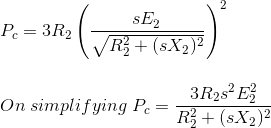 The ratio of P2 : Pc : Pm = 1 : s : (1 – s)
The ratio of P2 : Pc : Pm = 1 : s : (1 – s)
Where, P2 is the rotor input,
Pc is the rotor copper losses,
Pm is the mechanical power developed. Substitute the value of Pc in above equation we get,
Substitute the value of Pc in above equation we get, On simplifying we get,
On simplifying we get, The mechanical power developed Pm = Tω,
The mechanical power developed Pm = Tω, Substituting the value of Pm
Substituting the value of Pm We know that the rotor speed N = Ns(1 – s)
We know that the rotor speed N = Ns(1 – s)
Substituting this value of rotor speed in above equation we get, Ns is speed in revolution per minute (rpm) and ns is speed in revolution per sec (rps) and the relation between the two is
Ns is speed in revolution per minute (rpm) and ns is speed in revolution per sec (rps) and the relation between the two is Substitute this value of Ns in above equation and simplifying it we get
Substitute this value of Ns in above equation and simplifying it we get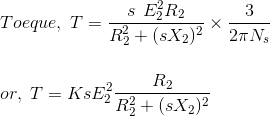
 |
Download the notes
Principles of Torque Production
|
Download as PDF |
Maximum Torque Condition for Three-Phase Induction Motor
In the equation of torque, The rotor resistance, rotor inductive reactance and synchronous speed of induction motor remain constant. The supply voltage to the three phase induction motor is usually rated and remains constant, so the stator emf also remains the constant. We define the transformation ratio as the ratio of rotor emf to that of stator emf. So if stator emf remains constant, then rotor emf also remains constant.
The rotor resistance, rotor inductive reactance and synchronous speed of induction motor remain constant. The supply voltage to the three phase induction motor is usually rated and remains constant, so the stator emf also remains the constant. We define the transformation ratio as the ratio of rotor emf to that of stator emf. So if stator emf remains constant, then rotor emf also remains constant.
If we want to find the maximum value of some quantity, then we have to differentiate that quantity concerning some variable parameter and then put it equal to zero. In this case, we have to find the condition for maximum torque, so we have to differentiate torque concerning some variable quantity which is the slip, s in this case as all other parameters in the equation of torque remains constant.
So, for torque to be maximum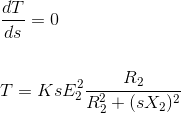 Now differentiate the above equation by using division rule of differentiation. On differentiating and after putting the terms equal to zero we get,
Now differentiate the above equation by using division rule of differentiation. On differentiating and after putting the terms equal to zero we get, Neglecting the negative value of slip we get
Neglecting the negative value of slip we get So, when slip s = R2 / X2, the torque will be maximum and this slip is called maximum slip Sm and it is defined as the ratio of rotor resistance to that of rotor reactance.
So, when slip s = R2 / X2, the torque will be maximum and this slip is called maximum slip Sm and it is defined as the ratio of rotor resistance to that of rotor reactance.
|
19 videos|93 docs|25 tests
|
FAQs on Principles of Torque Production - Electrical Machines - Electrical Engineering (EE)
| 1. What is the maximum torque condition for a three-phase induction motor? |  |
| 2. What are the principles of torque production in a three-phase induction motor? |  |
| 3. How do you calculate the maximum torque condition for a three-phase induction motor? |  |
| 4. What factors affect the torque production in a three-phase induction motor? |  |
| 5. Why is it important to understand the principles of torque production in a three-phase induction motor? |  |



























